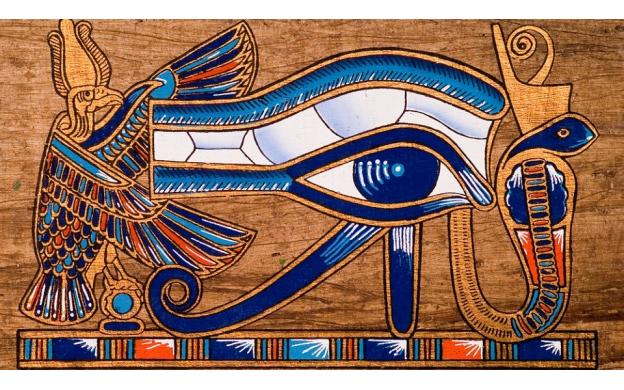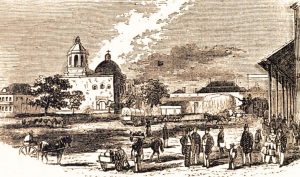Horus, the god of both the daytime sky and of war, is one of the most interesting and confusing of the Egyptian gods. Horus is often depicted as a falcon, or at times as a man with a falcon head–as were many other gods such as Har, Heru, or Hor.1 What is known about him is that he is the son of Osiris and an enemy of Set, the god of the night sky. Horus was, in ancient times, considered to be the perfect god for unifying Upper and Lower Egypt, even before the actual unification took place. This is due to the fact that he was considered the greatest of the gods in both parts of Egypt. The pharaoh was actually considered to be an embodiment of Horus.2
This myth formed the foundations of ancient Egyptian religious faith. This is because when the pharaoh died it was believed that he would become one with Osiris, the father of Horus, ensuring Egyptians eternal life after death. Egyptologist Rosalie David explains, “As the incarnation [flesh-and-blood form] of the god Horus, and the son of Ra and divine heir, only [the pharaoh] could act as mankind’s agent in the presence of the gods. The Egyptians considered the rituals to be effective only if they were enacted by the king to whom the gods had given the rulership. Only he could attend to their needs and execute their orders.”3
Also known as Wadjet, the Eye of Horus is commonly seen as a symbol of protection. The symbol appears in much of the jewelry in the ancient world as it brings about “the safety and health of the bearer and provide wisdom and prosperity.”4 The actual eyes can still be seen today in that they were considered–literally–to be the sun and moon. When Horus was still young, Seth, his uncle and god of the night, tore out his eyes after murdering his father Osiris. This version of the myth is actually quite disturbing as it states that Seth tears out Horus’ left eye, and through an odd set of events loses his man parts! Thoth magically restores the eye after being called upon by Horus’ mother, giving it the name Wadjet, and it is for this reason that the waxing and waning of the moon occurs in cycles and the moon is torn away before its renewal every lunar month.5 On top of that, Thoth resurrected Osiris, granting him eternal life.

In one of the many versions of the myth, the right eye of Horus (representative of the sun) was torn out by Set during battle. Djehuty restored most the eye except for a small piece. This missing part is where the myth of Horus-eye fractions stems from. In this system, parts of the eye were assigned fractional equivalents ranging from 1/2, 1/4, 1/8, 1/16, 1/32, to 1/64.6 When added, these fractions total 63/64, known in mathematical circles as a reciprocal 2n series and a complementary fraction. The Horus-eye of fractions was used for measuring grains and medicines.7
The Wedjat symbol was depicted in a variety of ways in ancient Egypt. Many Egyptians would wear it as an amulet fashioned from gold, silver, granite, hematite, porcelain, or wood.8 It was worn to bring strength, protection, safety, and good health. In a ritualistic sense, the amulet was made as offerings during the summer solstice when the sun was “the most powerful.”9 In fact, the eye still represents a sign that is seen in today’s modern medical vernacular: Rx.10 The Wedjat was printed on papyrus documents containing medical information. The symbol has continued to be used on medical record in Europe, but over time it was replaced by the symbol of Jupiter from Roman mythology, and as even more time passed was changed to the symbol we all know today as Rx.
- Philip’s Encyclopedia, 2007, s.v. “Horus.” ↵
- Philip’s Encyclopedia, 2007, s.v. “Horus.” ↵
- Don Nardo, Egyptian Mythology (Detroit: Lucent Books, 2013), 48. ↵
- Encyclopedia of African Religion, 2009, s.v. “Eye of Horus,” by Denise Martin. ↵
- Encyclopedia of African Religion, 2009, s.v. “Eye of Horus,” by Denise Martin. ↵
- Encyclopedia of African Religion, 2009, s.v. “Eye of Horus,” by Denise Martin. ↵
- Encyclopedia of African Religion, 2009, s.v. “Eye of Horus,” by Denise Martin. ↵
- Encyclopedia of African Religion, 2009, s.v. “Eye of Horus,” by Denise Martin. ↵
- Encyclopedia of African Religion, 2009, s.v. “Eye of Horus,” by Denise Martin. ↵
- Encyclopedia of African Religion, 2009, s.v. “Eye of Horus,” by Denise Martin. ↵



44 comments
Fumei P.
The idea that this symbol was used as a measuring device for medical purposes is fascinating. The Egyptians always seemed to be ahead of their time. I’ve seen this symbol before that I knew that it was associated with protection, I’ve seen necklaces and even tattoos with this design. The mythology is also very interesting, the hate and jealously of Seth his uncle tearing out his eyes, very symbolic.
Joshua Castro
I have always been fascinated about both Greek and Egyptian mythology. I have known that the eye of Horus was a major and important symbol for the egyptians, But was not aware of the significance that was behind it. Learning about the myth of how the eye of Horus was removed and replaced representing the phases of the moon was really interesting and I had no idea that the eye of Horus was used as a measuring system. This was an overall fascinating read!
Natalia Flores
The mathematical division of the eye of Horus and the myth of how he lost a part of his eye is mind blowing. The whole thing of the math adding up to 63/64 is a clear and concise way of representing mythology. I do wonder how heavy those necklaces were since they were made out of porcelain and granite and how big they were.
Natalie Childs
I just finished reading the other article on the Eye of Horus, and when I saw this one, I wanted to read it to see the different perspectives. I really like how this focused on the myth of Horus and his reputation as a god, and how that went on to form the foundations of an ancient religion, as well as all of the uses and meaning that the eye stand for.
Kailan Pena
This article was very interesting, as I really love the Egyptian culture. I know this symbol is a very important one, I just never knew why it was important and what it represented, so this article was wonderful in clearly defining how it came to be and its importance. Very well-written article with interesting points on the eye of Horus, I enjoyed it a lot!
Arianna Kennet
It is funny how I came across this article as I have a necklace with a pendant which has a design and pattern similar as to the one shown in your diagram above. The person I bought it from said that the pendant symbolized protection, just like it was mentioned in your article. The part about the right eye and the fractions had me lost for a bit, but I think I get the picture. An interesting read.
Destiny Flores
This egyptian symbol of the eye is such an iconic symbol for the egyptian culture. It’s seen so frequently yet I never knew the story behind it and find it quite fascinating. It’s also interesting how the symbol itself holds meaning towards a numerous amount of categories such as spirituality and history and also how its very specific down to event the measurements. Very informational article!
Marlene Lozano
I find this article very interesting and detailed. I have heard of the Wadjet symbol before but never fully understood where it came from or the story behind it. It is amazing that the symbol of Rx used to be the Wadjet. The story of the Egyptians have always seemed to be interesting to me so this article really caught my eye. I was surprised to find out that the eye of Horus was once used to measure medicine. Overall this was a great article!
Edgar Ramon
I had read somewhere that the Wadjet was a symbol of protection, and have seen it in several places. This article is very interesting, I did not know the myth behind the symbol, and now I do. The left eye of Horus teared out by Seth. I do know that ancient sailors painted this on their boats, although today the most frequent association made is with this symbol is in groups such as the freemasons.
Jazmin Pizana
Very interesting article! I’ve always been interested in Egyptian culture just never took the time out to actually read or learn about it! The images you used were really great! They’re appealing and drew me in from the beginning. I’ve heard of the Eye of Horus before and have seen it on jewelry but I never knew what it meant. It’s interesting to see how it can be seen in today’s society.